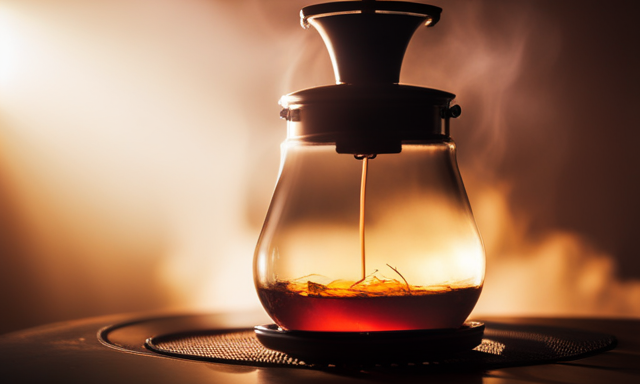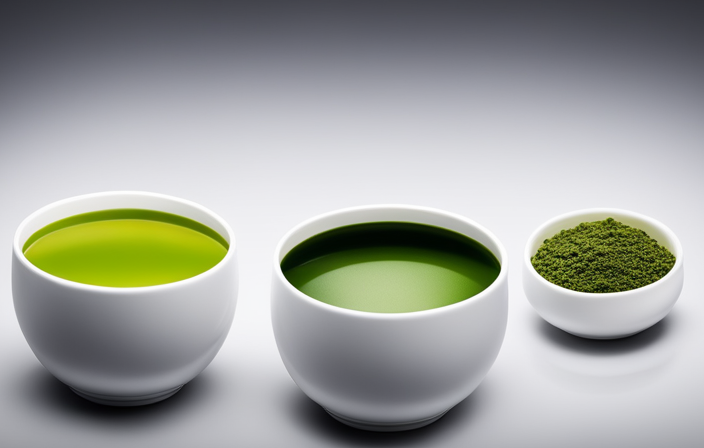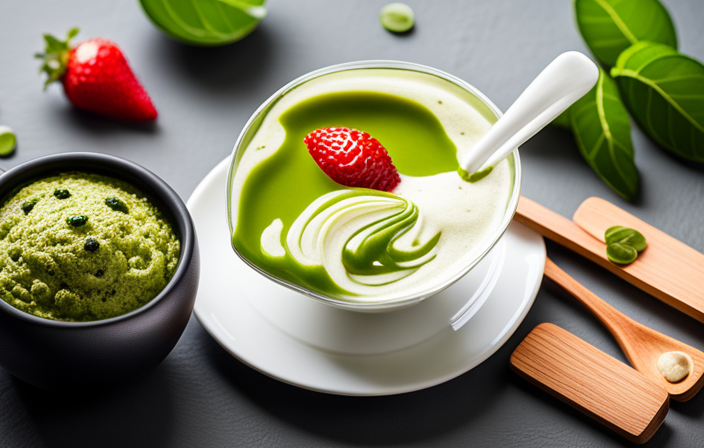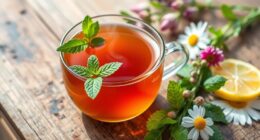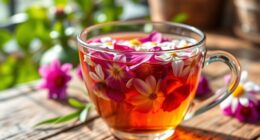As someone who wants to take control of my blood sugar levels, I have discovered the potential impact of green tea.
This article explores how green tea can help in controlling and reducing blood sugar levels. From improving insulin sensitivity to lowering blood sugar levels, green tea offers numerous benefits.
Backed by scientific evidence, this article aims to address common questions and concerns about green tea’s role in blood sugar control.
Join me as we explore the power of green tea in managing blood sugar levels.
Key Takeaways
- Green tea improves insulin sensitivity and glucose metabolism.
- Green tea increases glucose uptake by cells.
- Green tea enhances blood sugar control and helps regulate blood sugar levels.
- Green tea decreases the risk of developing type 2 diabetes.
The Role of Green Tea in Improving Insulin Sensitivity
I have recently discovered that drinking green tea daily can greatly improve my insulin sensitivity. Insulin resistance is a common condition where the body’s cells become resistant to the effects of insulin, leading to elevated blood sugar levels.
Green tea contains bioactive compounds, such as catechins, which have been shown to enhance glucose metabolism and increase insulin sensitivity. Studies have found that green tea consumption can reduce fasting blood sugar levels and improve insulin resistance in individuals with type 2 diabetes.
These beneficial effects may be attributed to the ability of green tea to enhance insulin signaling pathways and increase glucose uptake by cells. By improving insulin sensitivity, green tea can help regulate blood sugar levels and reduce the risk of developing diabetes.
Transitioning into the next section about green tea’s effect on lowering blood sugar levels, it’s important to explore the mechanisms behind this potential benefit.
Green Tea’s Effect on Lowering Blood Sugar Levels
Based on current research, green tea can effectively lower blood sugar levels by enhancing insulin sensitivity and increasing glucose uptake by cells. This makes green tea a promising beverage for individuals looking to control and reduce their blood sugar levels.
Green tea has been shown to improve glucose metabolism, which is important for maintaining stable blood sugar levels. By enhancing insulin sensitivity, green tea can help the body’s cells better respond to insulin, the hormone responsible for regulating blood sugar.
Additionally, green tea has been found to increase glucose uptake by cells, allowing for better utilization of glucose as an energy source. These effects can have a positive impact on weight management and overall metabolic health.
Incorporating green tea into a balanced diet and active lifestyle may be beneficial for individuals looking to support healthy blood sugar levels.
Reducing the Risk of Type 2 Diabetes With Green Tea Consumption
Through regular consumption of green tea, individuals can significantly decrease their risk of developing type 2 diabetes by improving insulin sensitivity and glucose metabolism. Green tea has been shown to contain beneficial compounds, such as catechins and polyphenols, which have antioxidant and anti-inflammatory effects. These compounds help regulate blood sugar levels and enhance the body’s ability to use insulin effectively.
Additionally, green tea has been linked to weight management, as it can boost metabolism and increase fat oxidation. However, it’s important to note that excessive consumption of green tea may have potential side effects, such as caffeine sensitivity, gastrointestinal issues, and interactions with certain medications. Therefore, it’s recommended to consume green tea in moderation and consult with a healthcare professional if you have any concerns or pre-existing medical conditions.
Scientific Evidence Supporting Green Tea’s Impact on Blood Sugar Control
According to recent studies, green tea has been found to have a positive impact on blood sugar control. This is great news for individuals looking to maintain stable blood sugar levels and reduce the risk of developing conditions like diabetes. Green tea contains bioactive compounds, such as catechins and polyphenols, which are believed to play a role in its mechanisms of action. These compounds have been shown to improve insulin sensitivity, increase glucose uptake by cells, and reduce glucose production in the liver. However, it’s important to note that the recommended daily intake of green tea for blood sugar control varies depending on individual factors such as age, weight, and overall health. It’s always best to consult with a healthcare professional to determine the appropriate amount of green tea to incorporate into your daily routine.
| Mechanisms of Action | Recommended Daily Intake |
|---|---|
| Improved insulin sensitivity | Varies depending on individual factors |
| Increased glucose uptake by cells | Consult with a healthcare professional |
| Reduced glucose production in the liver | for personalized recommendations |
Addressing Common Questions and Concerns About Green Tea and Blood Sugar Control
I have been hearing a lot of questions and concerns about the effects of green tea on blood sugar control. It’s understandable that many people are interested in this topic, as blood sugar control is crucial for overall health, especially for individuals with diabetes or pre-diabetes.
Green tea is often touted for its potential health benefits, including its impact on blood sugar levels. While green tea does contain compounds that may help improve insulin sensitivity and regulate blood sugar, it’s important to note that the effects may vary from person to person.
Additionally, it’s crucial to consider the recommended daily intake of green tea and potential side effects. Consuming moderate amounts of green tea, about 2-3 cups per day, is generally considered safe. However, excessive consumption or combining green tea with certain medications may lead to adverse effects.
It’s always best to consult with a healthcare professional for personalized advice.
Frequently Asked Questions
Can Green Tea Completely Replace Traditional Medication for Controlling Blood Sugar Levels?
Green tea alternatives may have some impact on blood sugar levels, but they cannot completely replace traditional medication. Long-term effects of relying solely on green tea for controlling blood sugar levels are unknown.
Are There Any Potential Side Effects or Risks Associated With Consuming Green Tea for Blood Sugar Control?
When it comes to potential side effects and risks of green tea for blood sugar control, it’s important to consider if they are significant. Let’s explore this topic to better understand the potential risks involved.
Can Green Tea Consumption Prevent the Development of Type 2 Diabetes in Individuals at High Risk?
Green tea consumption has been shown to have benefits in preventing the development of type 2 diabetes in individuals at high risk. It helps improve insulin resistance, which plays a key role in the development of diabetes.
How Much Green Tea Should Be Consumed Daily to Effectively Lower Blood Sugar Levels?
To effectively lower blood sugar levels, I recommend consuming green tea daily. Studies suggest that green tea consumption can aid in weight loss and regulate blood pressure, which may contribute to better blood sugar control.
Is There a Specific Type or Brand of Green Tea That Is More Effective in Controlling Blood Sugar Levels?
In my experience, I’ve found that different types and brands of green tea can vary in their effectiveness in controlling blood sugar levels. It’s important to do some research and find one that works best for you.
Conclusion
In conclusion, green tea has shown promising effects in controlling and reducing blood sugar levels. It improves insulin sensitivity, lowers blood sugar levels, and reduces the risk of developing type 2 diabetes.
Scientific evidence supports the positive impact of green tea on blood sugar control. So, if you’re looking for a practical and evidence-based approach to managing blood sugar levels, incorporating green tea into your daily routine could be a beneficial choice. Just remember, it’s always important to consult with your healthcare provider for personalized advice.


